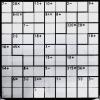-
Posts
6975 -
Joined
-
Last visited
-
Days Won
66
Content Type
Profiles
Forums
Events
Gallery
Blogs
Everything posted by bonanova
-
-
WOLOG isn't needed in my previous explanation. Rather, Coin 3 goes into one of the urns. Call that urn X. Now x/y = 2 and for Coin 4, p(X)/p(Y) = 2 which on average maintains <x>/<y> = 2, making min = 333 333. And, if you could add frational coins, that is the correct result. But...
-
This is the hardest I've found. I have not solved it. It may not be clear that cell (9,4) is given as 4. The puzzle turns on whether 84x is 7-2-6 or 7-3-4, and I've run into dead ends both ways.
-
Thanks for the programming detail. I'm learning how to do java programming. You get an area of 1.0984, a rational number. But it can be bigger than that.
-

Pushing objects through holes in other objects
bonanova replied to bonanova's question in New Logic/Math Puzzles
To be the first on your block, perhaps. Otherwise I don't know. -
I agree. And my edit was meant to debunk my first notion. I did the calculation for three bridge placements in the (easiest) case of placing A on the river's edge, very similar to your drawing. The three placements had the east end, the west end and the middle of the bridge on the joining line. My code for the middle placement had an error, but it was clear that that case would not minimize the road length - the east-end placement was going to be the best of the three. The considerations I posted above to AP come into play, and I agree the general case is far from trivial -- both to calculate and to optimize. I think it can be done, but I put it away last night for possibly another time.
-
Well, except that we are given the river as is, with a fixed width and a bridge perpendicular to its flow. We do not know whether the line joining the cities lines up with the bridge - a very special case with a trivial solution. We also do not know that the cities are equidistant from the river - a fact that bears on bridge placement if is not parallel to the joining line. I'm curious to know the two different ways BMAD has to optimize the bridge placement.
-
Perfect. That is a proof. And even tho not all square roots are irrational this one is. Now, I'm looking for a proof that begins with the assumption that g is rational and show that it leads to an impossible result.
-
Brute force or computer simulations are often brought to bear on mathematical problems. Among the motivation for using these approaches is they can obviate the need for careful thought. But careful thought often shows a simpler path to the answer. Occasionally, by argument from analogy to already solved problems, or invoking properties of the type of expression, for example, that the answer must possess, a solution can be found without seemingly solving the puzzle at all. Or, if an equation must be solved, it's one much simpler than first thought. Some people refer to these solutions as coming to them in what they call "Aha!" moments. I will post a series of "Aha!" puzzles, starting with a rather easy one. The Golden Ratio g has a number of definitions. The one that provides the best clue to our answer is to note that a rectangle of dimensions g x 1 has the property that if it is cut into a square and another rectangle, the second rectangle has the same proportions as the first. Prove that g is irrational. I know its usual symbol is Greek phi; but I don't know how to make one here.
-
A classic problem is to push the largest possible cube through a square hole in a unit cube. That solution involves hexagons and involves the same calculation as finding the area of the The late inventor of "recreational mathematics" Martin Gardner believes he was the first to take things to a higher dimension by asking for the largest cube that will fit entirely inside a unit hypercube. I know the answer but I would not attempt its derivation myself. This would be one of the more difficult puzzles ever posted on Brain Den. Even the coveted bonanova gold star seems too small a prize for anyone who finds the answer. It's on m172. Happy hunting.
-
A little too large, but close. And the answer is in fact a rational number. If it helps, there is a close relation to the question that asks whether a cube can be pushed through a square hole in a smaller cube.
-
Since it's a unit cube, your answer simplifies (if I'm reading it correctly) to Sqrt(2) / 2 = .707. This is smaller than a cube face. But maybe I don't interpret your answer correctly.
-
What is the area of the largest square that can fit entirely within a unit cube?
-
No other conditions, although if you want something really interesting try having a continuous function... Yup, in fact that's the assumption I made.
-
Can you hang a 4-d object in 3-d space?
-
Has a familiar ring. Glad it got stated clearly this time and the solution was found.
-
Are there conditions other than being one-to-one and onto?
-
Can we reposition the laser?
-
What you have found is that the 5's in columns 7 and 8 go, one each, in the 3- and the 280x clusters. Possibly in cells (7,1) and (8,5). If not, then in cells (8,1) and (7,4) or (7,5). And you have found that the 7's in columns 5 and 6 go, one each, in the 21x and the 84x clusters. Possibly in cells (6,1) and (5,7). If not, then in cells (5,1) and (6,6) or (6,7). You're making progress.
-
In your diagram, I would insert 6 above 2. Cells (5,5) and (5,6) respectively.
-
I want to share the most unlikely 9-ball shot of my lifetime. I and two close friends shoot cutthroat nine-ball on Monday nights. We have done this for more than twenty-five years. When asked if we play for money, we smile and say that we play for something much more important. We have great fun, and the competition rarely overshadows our friendship. I should say that cutthroat (3-way) 9-ball would never work at all for professional caliber players. The third player would rarely get a shot. We customarily make only a few balls each turn. So for us it works. Rarely will one of us break and run the table. The play in question was a kick-combination-carom-combination shot that went the length of the table twice and ended with barely enough energy for the nine ball to drop. My opponent had broken without pocketing a ball. I could have called a "push" because I did not have a clear shot; the one ball was partially blocked by both the two and three balls. But something about the lay of the table caught my eye. I show only four balls, but in the actual case five other balls provided the usual visual clutter and obstructions; the shot was not so clear as the graphic makes it seem. The only path to the object ball came by driving the cue ball hard into the opposite rail with a huge amount of left English. The one and two balls seemed fortuitously aligned to send the two ball back down the table toward the three, sitting on the spot; the nine then lay between it and the corner pocket. With luck, the two would carom off the three at just the right angle to strike the nine into the pocket. It was a long shot among long shots, but as I took a close look at the one and two balls, I concluded it just might work. After a final look, I announced the shot. We play by a rule that the nine ball must always be called; and every rail, combination and carom, not just the pocket, must be precisely described. I assumed a completely unjustified air of confidence as I carefully traced the shot with my cue stick, as a maestro might use his baton to direct an orchestra through a difficult passage of music. My opponents obliged by rolling their eyes, and the stage was set. I stroked the cue as hard as I could, hoping the extreme left English would not cause a miscue. And it happened. The two ball came back up table as I hoped, and it was off-center from the three on just the right side. It took an eternity, but the angle stayed true as it drew closer. It struck the three spot on, and retained just enough speed to strike the nine into the center of the pocket. Without comment, I sat down and quietly chalked my cue for the next rack. As these things go, and given the chaos guaranteed by the second law of thermodynamics, good fortune will never smile so sweetly again.




